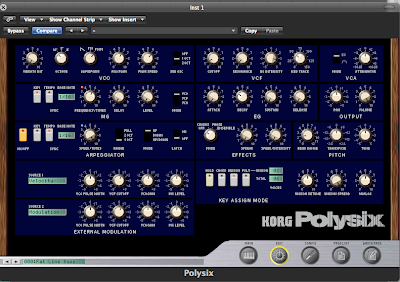 It's funny, but different styles of electronic music are almost identifiable by the types of bass sounds they use alone. Would drum n' bass sound like drum n' bass if it wasn't for the nasty, hyper-filtered bass shudders? Would acid sound like acid without a 303 or 202? Would dubstep be dubstep without the LFO wobbles?
It's funny, but different styles of electronic music are almost identifiable by the types of bass sounds they use alone. Would drum n' bass sound like drum n' bass if it wasn't for the nasty, hyper-filtered bass shudders? Would acid sound like acid without a 303 or 202? Would dubstep be dubstep without the LFO wobbles?Today, I'm going to show you how to quickly and easily make a typical modern EBM bass sound. This genre tends to favor fat and aggressive bass sounds that are very percussive to allow for rapid, 16th-note basslines. So those are the parameters we're going to follow for this tutorial. Obviously there is no 'right' sound you have to use if you're making a particular genre. This is just a starting point to one of many options. As always, you should experiment on your own to customize the sounds to your liking.
1. Fire up a synth or softsynth that offers Pulse Width Modulation and a unison function. I'll be using Korg's Polysix plug-in because it's a simple synth and the default patch already happens to be a nice synth bass. Go ahead and program a quick bassline in your sequencer. I find it's nice to have something playing automatically as I tweak sounds.
2. The default Fatline Bass sound uses a sawtooth wave, which is great, but we're after as juicy and fat a sound as we can manage, so change the waveform to PWM (may be marked as Square or Pulse on other synths). The sound suddenly sounds a bit hollow. This is because we are playing it back with no pulse width modulation. Go ahead and set both the PW/PWM and the PWM Speed value to about 6. (If you're using another synth, you want to make sure Pulse Width Modulation is on and pushed to about a 60% value, and to set the speed to something moderate... in many cases you will adjust this on an LFO that has been assigned to modulate Pulse Width. It should sound a bit fatter now, almost a little detuned. But we're not done yet.
3. Tweak the Filter Cutoff to a low value, but not quite all the way closed, and up the EG Intensity to around 75%. The EG intensity controls how much the envelope opens and closes the filter's cutoff level, which will give the sound a bright attack and darker body resulting in 'plucked' sort of timbre.
4. If you're using the Polysix, your envelope settings should be pretty good as is. Otherwise, you want your envelope (both filter and amp, if your synth has separate ones) to have zero attack, a low decay (about 1/3 of the way up), zero sustain, and zero release.
5. Now for the final, fattening touch. Put your synth in Unison mode. (If you're using the Polysix, it should already be on...) This plays back several detuned copies of the sound to create super thick, fat textures. On the Polysix, bump the Unison Voices to 2, so each time we hit the key, it will use 2 detuned voices. Next, bump up the Unison Detune level to about halfway. (Higher values can sound wonderfully evil and rave-y, too...) Optionally, you can turn the Unison Spread (this spreads the detuned voices out in the stereo image for a wider sound). Bass generally works best in mono, but if you create your arrangement carefully, using a big stereo bass sound can sound really good. Finally, turn the Analog level up to 5. This parameter simulates the unstable turning of old analog synths and varies the pitch randomly in a pleasing way. You don't have to use this, but I really think it adds a little more character.
(You can click the picture at the top of this post for a larger version if you want to copy the settings...)
Here's what the end result sounds like:




















8 comments:
http://blog.divshare.com/
that should work for you
There's Soundcloud, but the free account only lets you upload something like 5 or 10 tracks a month...
Thanks, Visitour! Sound clip added...
Thanks so much Tom! I'd always wondered how you got your bass sounds, I just love them. Thanks for sharing the secrets!
Thanks, this will work for me, even at the very beginning!
Little doubt, the dude is completely fair.
Brilliant! ..Thank you so much mate
Cheers!
Thank you so much! Your tutorial has helped me enormously!!!!
Post a Comment